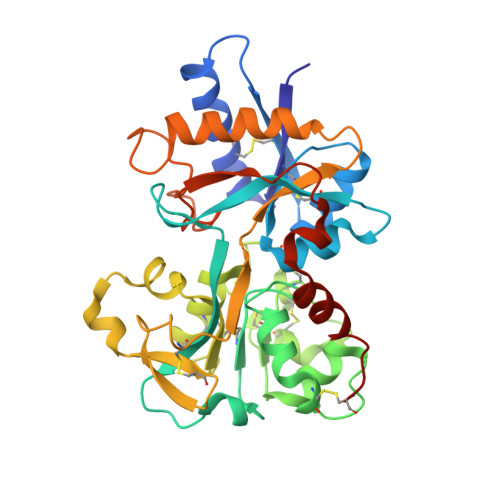Structures of two mutants that probe the role in iron release of the dilysine pair in the N-lobe of human transferrin.
Baker, H.M., Nurizzo, D., Mason, A.B., Baker, E.N.(2007) Acta Crystallogr D Biol Crystallogr 63: 408-414
- PubMed: 17327678
- DOI: https://doi.org/10.1107/S0907444907000182
- Primary Citation of Related Structures:
2O7U, 2O84 - PubMed Abstract:
Iron uptake by humans depends on the ability of the serum protein transferrin (Tf) to bind iron as Fe(3+) with high affinity but reversibly. Iron release into cells occurs through receptor-mediated endocytosis, aided by the lower endosomal pH of about 5.5. The protonation of a hydrogen-bonded pair of lysines, Lys206 and Lys296, adjacent to the N-lobe iron site of Tf has been proposed to create a repulsive interaction that stimulates domain opening and iron release. The crystal structures of two mutants, K206E (in which Lys206 is mutated to Glu) and K206E/K296E (in which both lysines are mutated to Glu), have been determined. The K206E structure (2.6 A resolution; R = 0.213, R(free) = 0.269) shows that a salt bridge is formed between Glu206 and Lys296, thus explaining the drastically slower iron release by this mutant. The K206E/K296E double-mutant structure (2.8 A resolution; R = 0.232, R(free) = 0.259) shows that the Glu296 side chain moves away from Glu206, easing any repulsive interaction and instead interacting with the iron ligand His249. The evident conformational flexibility is consistent with an alternative model for the operation of the dilysine pair in iron release in which it facilitates concerted proton transfer to the tyrosine ligand Tyr188 as one step in the weakening of iron binding.
Organizational Affiliation:
School of Biological Sciences, University of Auckland, Private Bag 92019, Auckland, New Zealand.
















